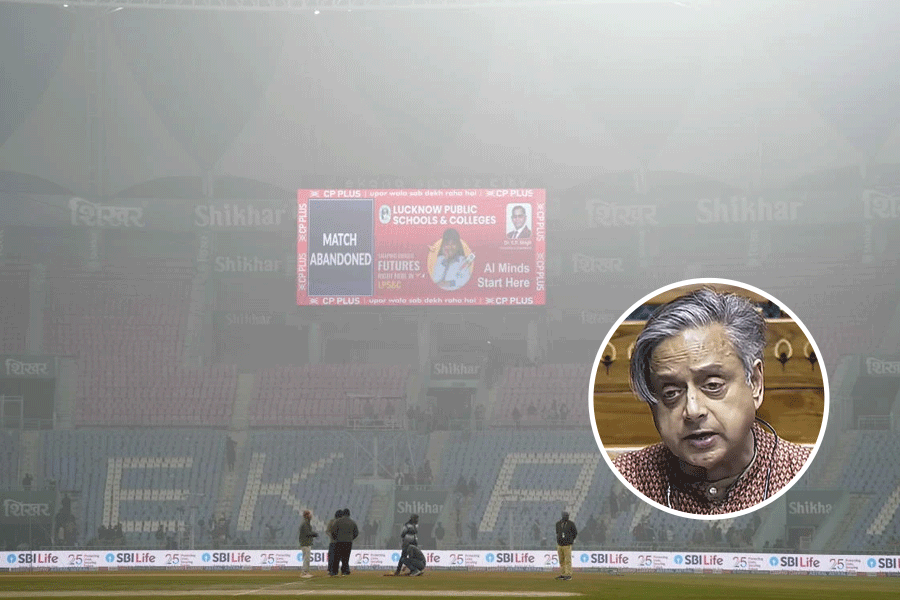-
.jpg)
Sandeep Kumar Maity is heading off to different corners of the world to participate in international bouldering competitions
It's dawn and the Lado Sarai Green Belt in Delhi is humming with activity. A group of climbers, with large square mattresses strapped to their backs, weave their way through spiky bushes and grazing cows before arriving in front of a giant and almost sheer boulder. The mattresses are strategically placed beneath the colossal rock and mosquito repellent dabbed on. One youngster then gets into Spiderman mode and starts clambering up the rock face, using his fingers to grasp the tiniest holds.
Just a stone's throw away, the city forest of Sanjay Van, is another 'bouldering' paradise. Climbers make their way down a dirt trail past scores of nilgai and peacocks to Thumbelina, a rocky offshoot of the Aravalli Range. They smear chalk dust on their palms and change into rugged climbing shoes and start their painstaking journeys up the sides of the rocks.
Welcome to the world of bouldering, a whole new discipline of climbing that's attracting a bevy of extreme adventure enthusiasts. Indeed, bouldering — the act of climbing almost sheer rocks and artificial walls without harnesses and ropes — is the new urban sport that's rapidly gaining a huge fan following. The climbs are short (not higher than 15ft usually) and a mattress-like crash pad is positioned to break falls. And there are spotters on the ground, directing the climber on how to find the next hand-hold and avoid a crash landing.
-
.jpg)
The Red Bull Indian Odyssey project was a highlight of Tuhin Satarkar’s bouldering career.Courtesy: Red Bull Content Pool
'There's a huge rush now,' says Sreedash Bhattacharjee, chairman, Indian Mountaineering Foundation (IMF), North Zone Committee. Interestingly, the IMF has recognised this and bouldering is now a category in the National Sport Climbing Championship that's scheduled to take place this year in Calcutta's Salt Lake Stadium in December.
'In 2001, when we launched a website dedicated to pure rock climbing and bouldering, less than 100 people were logging into it. Now we are looking at several thousands actively engaged in bouldering,' says Apoorva Prasad, founder and editor in chief, The Outdoor Journal, a lifestyle and adventure magazine.
Adds climber Vrinda Bhageria: 'When I started bouldering in IMF in 2010, non-competitive climbers almost never came to the bouldering area. But now I see more and more amateur climbers trying their hand at it.'
-
.jpg)
Abhinav Mishra has quit a high-flying career so that he can devote his life to bouldering
One reason why the sport is reaching new heights is that it's an activity that can take place both indoors and outdoors. Take a look at Manjiri Satarkar, national level climber and owner of the Pune-based climbing gym, Rock Aliens. She supervises indoor bouldering sessions every day and has also gone on bouldering expeditions to places like Hampi and Manali. 'Those who are looking for a fix of adventure can travel the world to climb their favourite rocks. Others can get in shape pursuing the indoor option in climbing gyms,' she says.
As the sport gains popularity, a small band of committed climbers are testing their skills on the competitive circuit, both in India and abroad. Take a look at New Delhi-based Sandeep Kumar Maity, whose climbing calendar is crammed till the year-end. In August he heads off to Bangalore to compete in the IMF South Zone Bouldering Competition. Next up in September is Rockmaster, a bouldering battle in Singapore, followed by the Asian Championship in Lombok, Indonesia. Other heavy-duty international bouldering challenges, including the Indonesia Open X-Sports Championship, are slated to round off 2014 for the 21-year-old Maity. 'It's going to be incredible,' he says.
A similar frantic schedule also awaits the Pune-based Tuhin Satarkar, one of India's top climbers. Apart from the string of contests where he will have Maity for company, the 18-year-old is also looking to compete at the Asian Youth Championship in Thailand as well a couple of bouldering competitions in Singapore. 'Every day you learn something new by watching international climbers,' says Satarkar.
Maity and Satarkar are not the only ones who are ascending to the very top of the Indian climbing scene. Others like Ajij Shaikh, Manikandan Kumar and Nehaa Prakash, too, are reaching for new peaks. For instance, Pune-based Shaikh, 23, who won a bouldering gold medal at the National Sport Climbing Championship in 2012, has managed to climb two 8a grade boulders named The Diamond and The Middle Way in Hampi. (The Fontainebleau bouldering grade system rates a climb using a mix of numbers (one to eight), letters and symbols, and higher numbers denote greater difficulty).
-
.jpg)
Ashish Khanijao goes to Delhi’s Lado Sarai Green Belt for his once-a-week climbs and workout sessions. Pic: Rupinder Sharma
Competitive bouldering is only for an intrepid handful and most climbers get their highs from the challenges presented by rocky outcrops in the great outdoors. Take Bangalore-based Kumar, who won a gold medal at the IFSC (International Federation of Sport Climbing) Paraclimbing World Championship in Paris in 2012 is constantly dashing off to picturesque spots in Karnataka like Turahalli, Antara Gange and Hampi. 'Climbers of every nationality can be found here, trying to make friends with the rocks,' says the 28-year-old.
One of the thrills of bouldering is that you can be a globetrotter in your quest for just the right rock to climb. So, some enthusiasts are heading off to international destinations where they can get their climbing kicks. You have Ashish Khanijao, a 29-year-old financial analyst turned businessman from Delhi, who is heading to world-famous bouldering locations like Rocklands in South Africa. Khanijao, fed on bouldering movies and videos shot in Rocklands, drove down from Cape Town to try out some of the region's classic climbs. 'Trying to climb The Rhino (it's a lookalike of the animal) boulder was incredible. One climbs completely parallel to the ground and there's a rock right in your fall zone,' says Khanijao, who also has fond memories of pitching his tent and cooking dinner on a camp stove in Rocklands.
Then Satarkar headed to Algund in Italy to climb rocks located right in the middle of vineyards. 'The cold was biting and yet the experience was extraordinary,' he says.
India too is turning into a hot bouldering destination. Acclaimed international climbers are making a beeline for the country's hot bouldering destinations in search of interesting climbing sessions. Austria's Kilian Fischhuber, who has five Bouldering World Cup wins under his belt, came down to India in January this year to participate in a climbing project called the Red Bull Indian Odyssey Part 2. Fischhuber rates Hampi as one of the biggest spots for bouldering worldwide. 'The potential for climbing in Hampi is endless,' he says.
Fischhuber is not alone. 'Other stars of the bouldering world, like Julien Nadiras and Micha Fuselier from France, have also trooped to India to be part of competitions organised by Girivihar and to explore unique bouldering environments in the country,' says Abhijit Burman, chief in charge of bouldering competitions at the Mumbai-based Girivihar Adventure Club.
-
.jpg)
Climbing greats like Michaël Fuselier have come all the way to India to be part of competitions
Interestingly, a raft of fresh bouldering spots within India is contributing to the swelling ranks of climbers. Picturesque landscapes like Vashisht, Chhota Dara and Chhatru in Himachal Pradesh, as well as Turahalli and Ramanagaram in Karnataka top the popularity stakes, apart from the all-time-favourite Hampi.
Inevitably, the training for bouldering is as strenuous as the sport. Delhi-based climber Abhinav Mishra says this form of specialised climbing makes the muscles rigid. 'All of your shoulder, back muscles, biceps and triceps get stiff. One has to do Yoga to stretch them out,' he says.
Maity has an exacting fitness drill that's needed to keep him rising to greater heights. Apart from a battery of workouts, he is into other sports like slacklining, where a tape (usually one inch) is set up above the ground, between two anchor points, on which people walk. 'The tape swings and balancing on it is supremely tough,' says Maity.
It should be emphasised that Indians hooked to climbing need brick-thick wallets. Khanijao estimates that a good pair of imported climbing shoes costs between Rs 10,000 and Rs 15,000. 'One can't do without the crash pad either, which will cost about Rs 5,000 for Indian brands. Big brands like Metolius or Black Diamond will cost between $150 and $300 (Rs 9,000 to Rs 18,000),' he says.
It's an even bigger financial drain for athletes on the competition circuit. For instance, Maity goes through six pairs of shoes a year for which he needs to shell out huge sums. 'When I go abroad, I get them myself or ask my friends to pick up a few pairs,' says the young climber.
But it should be stressed that nobody gets into bouldering for the money. The sport costs money and the rewards are nothing to write home about.
Most national contests offer negligible prize money and occasional handouts of climbing gear. Despite the odds, bouldering enthusiasts can't really explain their passion for it. Some like Kha-nijao and Mishra have quit high-flying jobs to continue their romance with the rocks. Most athletes survive on their own money or through sponsorships from friends. Bhageria puts it bluntly: 'It's completely changed my life.'

.jpg)








